Answered step by step
Verified Expert Solution
Question
1 Approved Answer
Do you agree with the recommended policy? Which parts? Is anything missing? The New Policy Statement on Project Finance Following these meetings, the team concluded
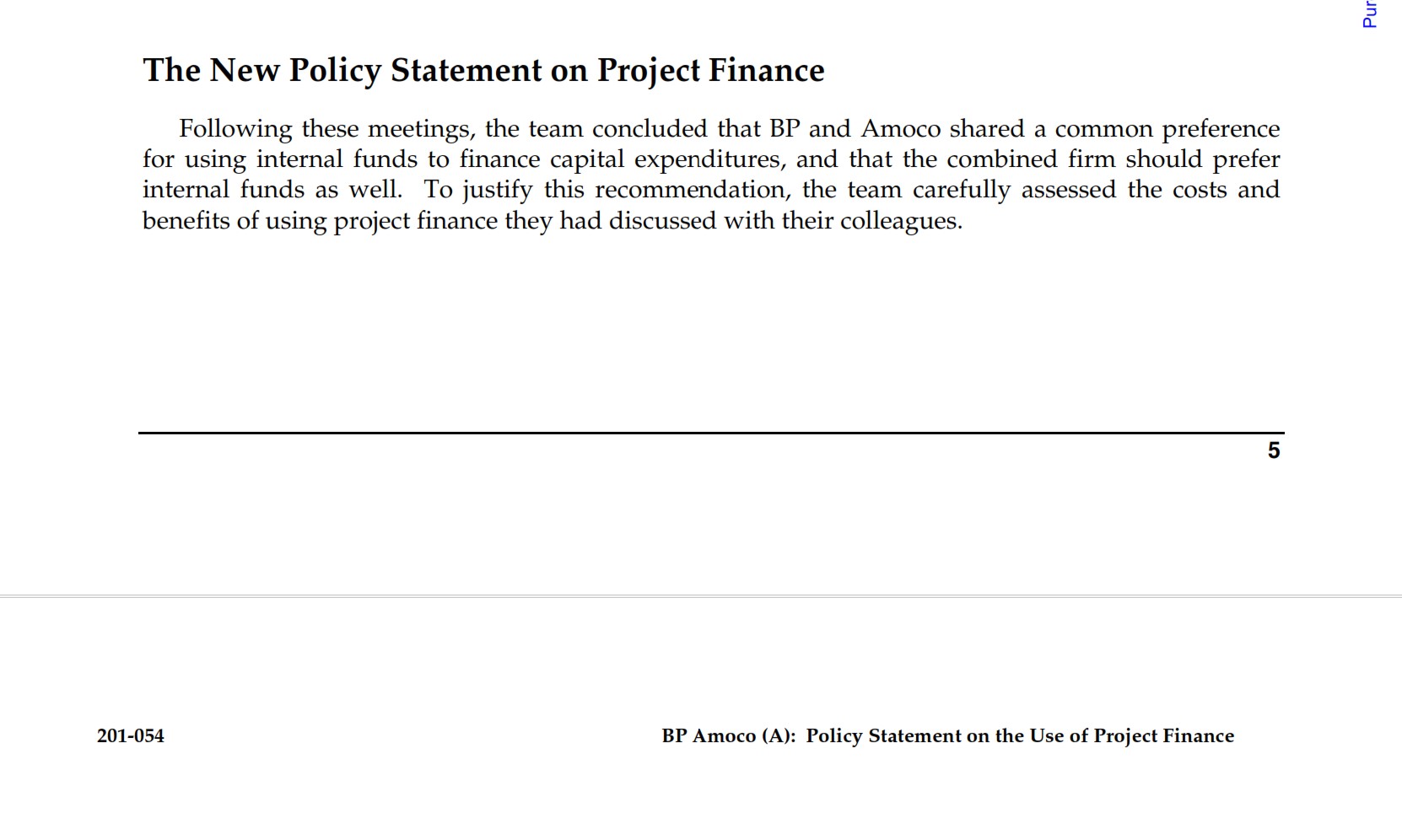
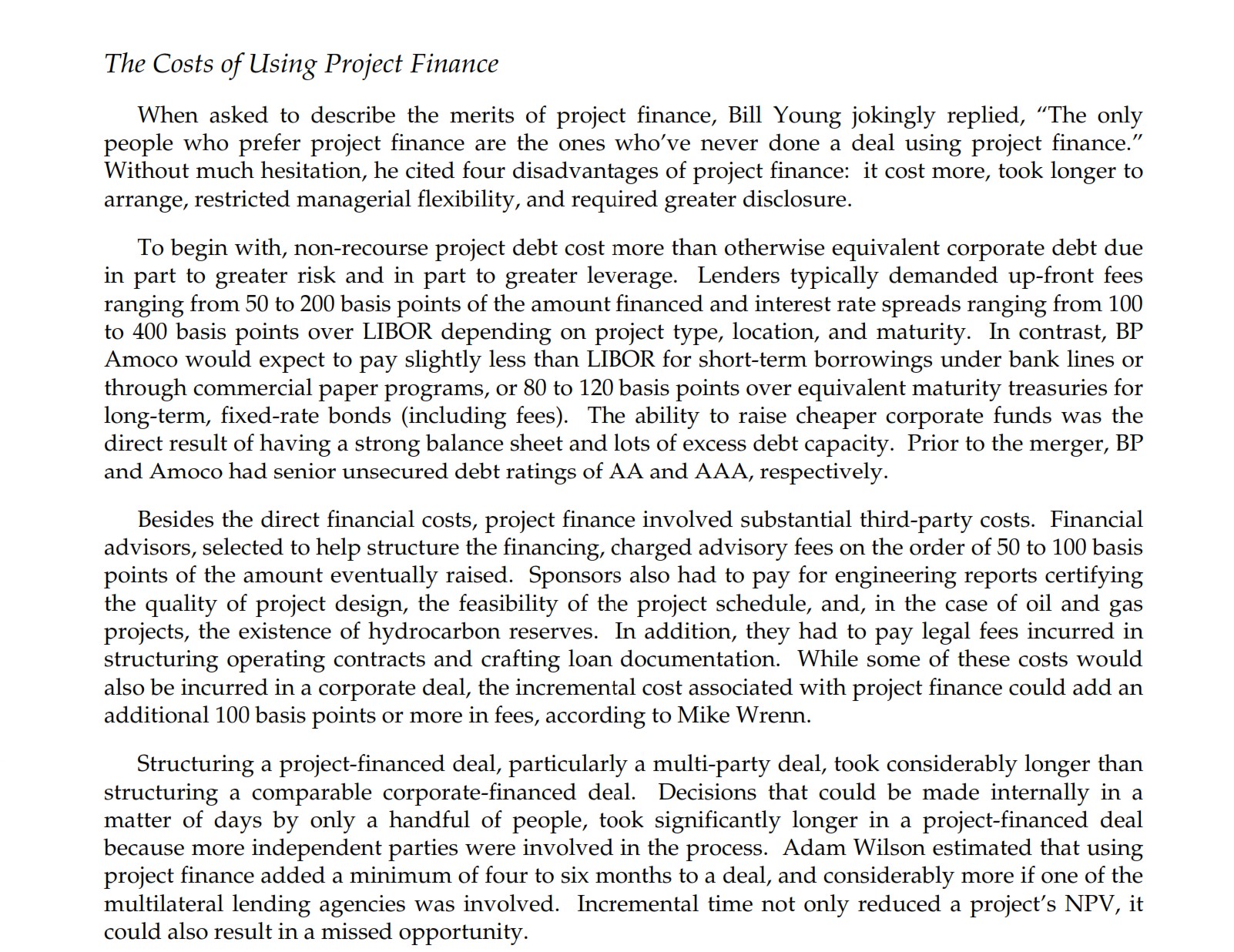
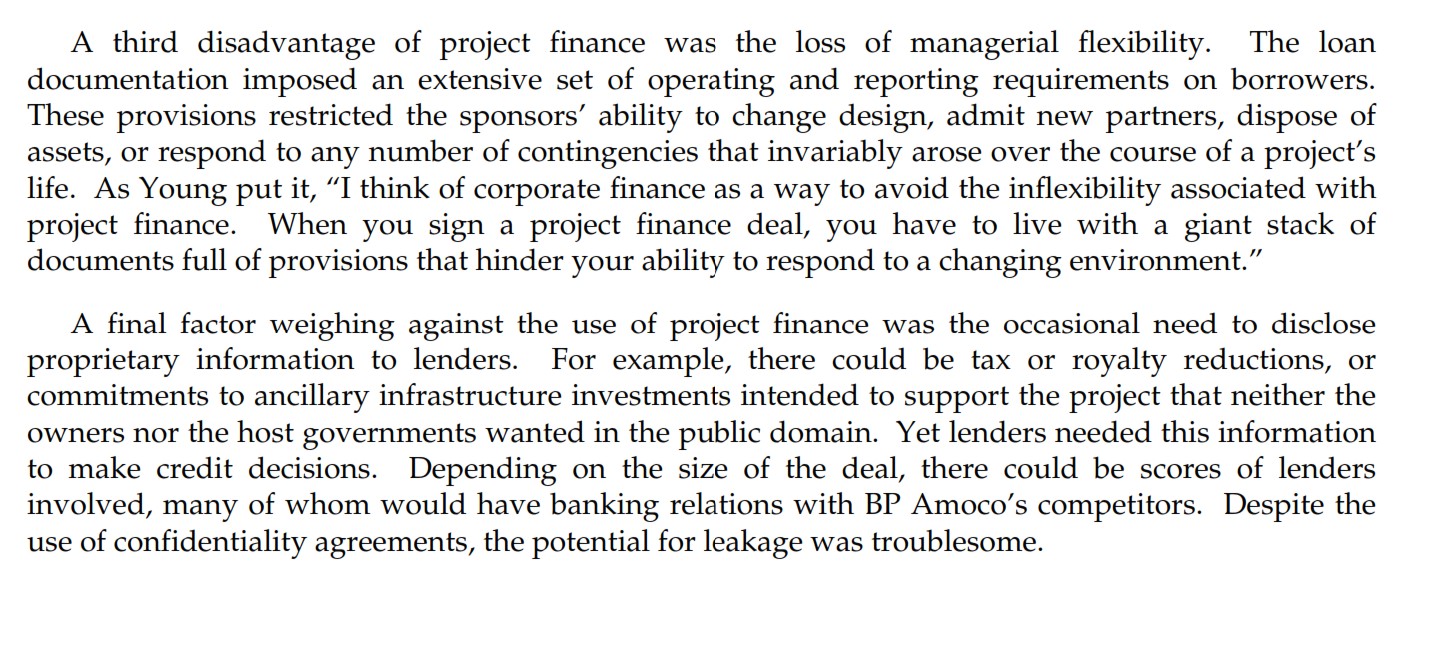
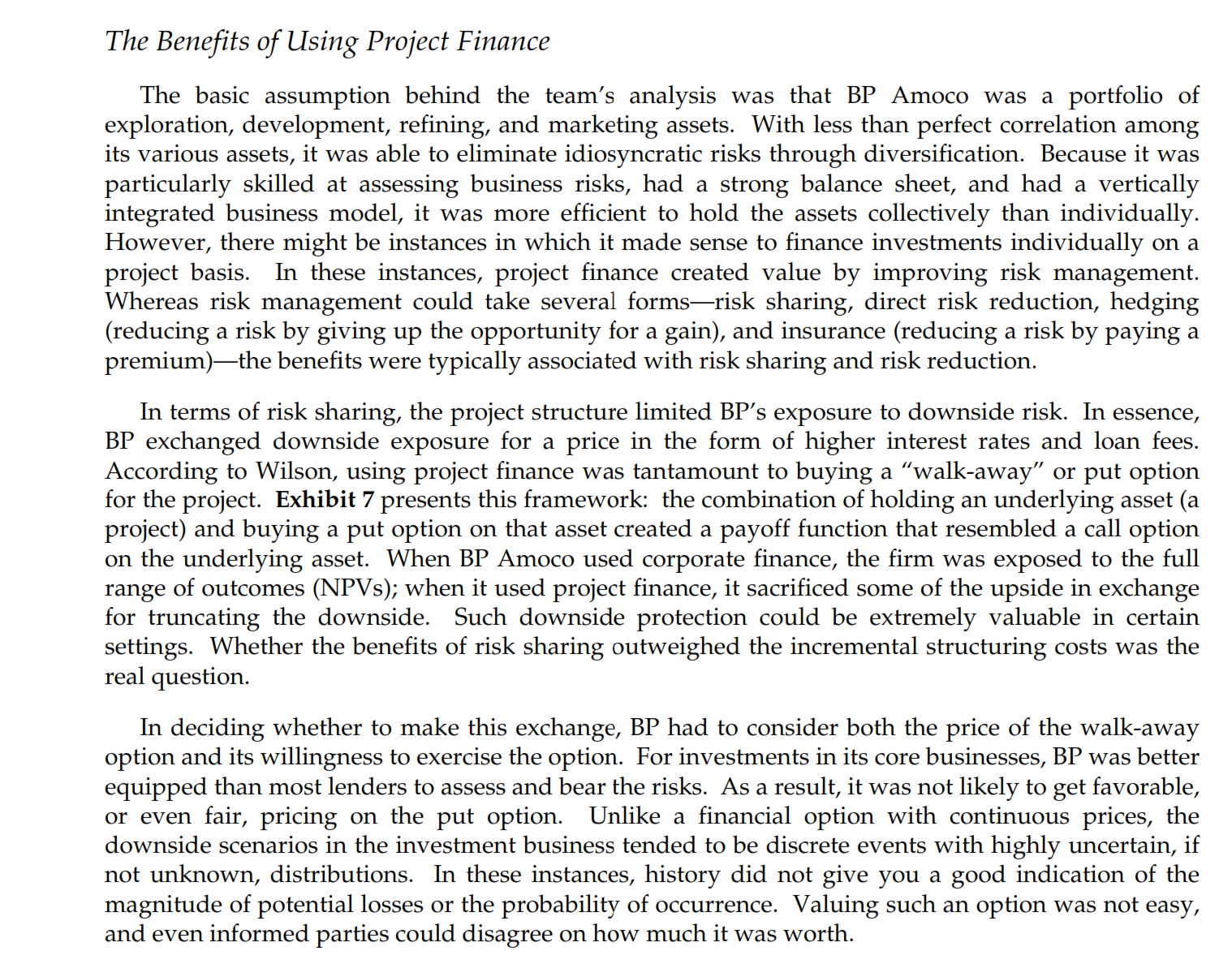
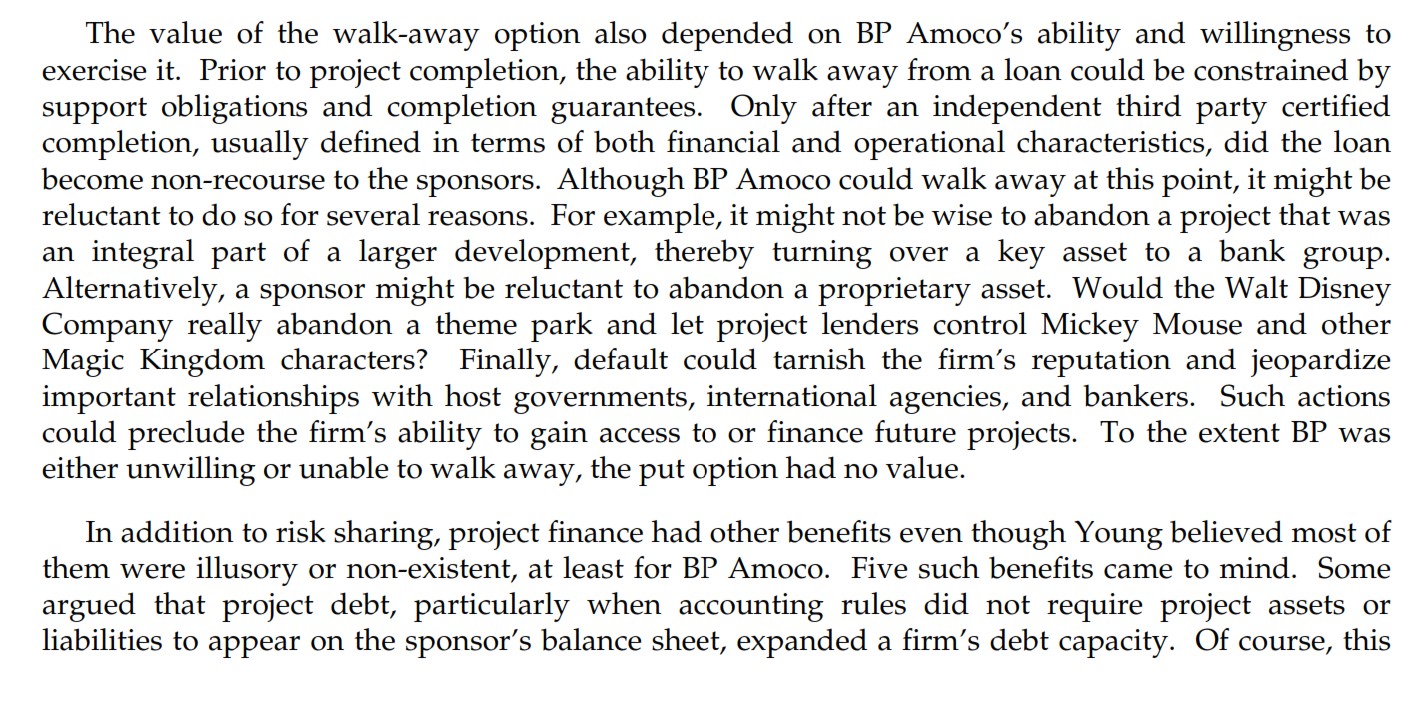
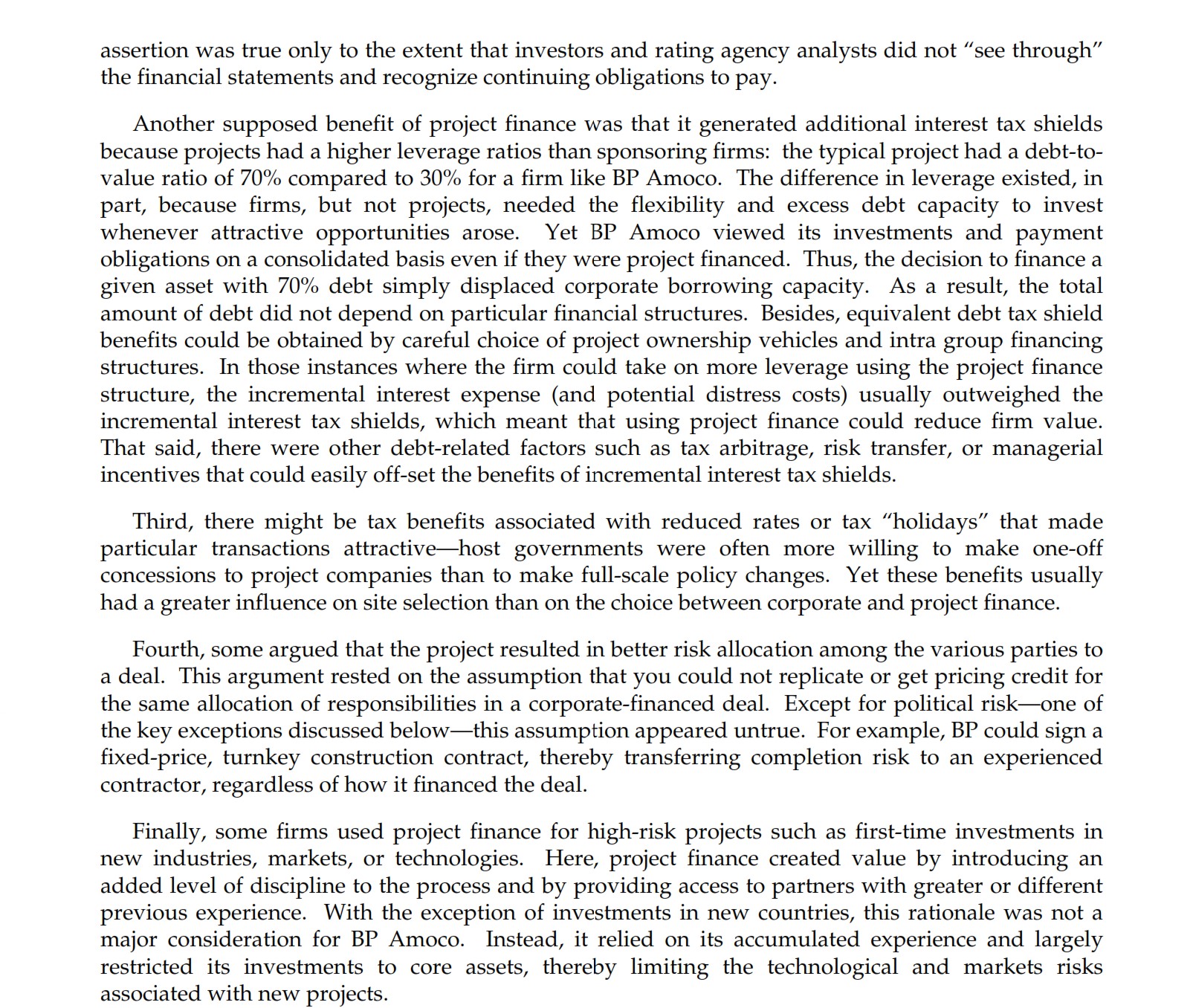
Do you agree with the recommended policy? Which parts? Is anything missing?
The New Policy Statement on Project Finance Following these meetings, the team concluded that BP and Amoco shared a common preference for using internal funds to finance capital expenditures, and that the combined firm should prefer internal funds as well. To justify this recommendation, the team carefully assessed the costs and benefits of using project finance they had discussed with their colleagues. 5 1054 BP Amoco (A): Policy Statement on the Use of Project Finance The Costs of Using Project Finance When asked to describe the merits of project finance, Bill Young jokingly replied, "The only people who prefer project finance are the ones who've never done a deal using project finance." Without much hesitation, he cited four disadvantages of project finance: it cost more, took longer to arrange, restricted managerial flexibility, and required greater disclosure. To begin with, non-recourse project debt cost more than otherwise equivalent corporate debt due in part to greater risk and in part to greater leverage. Lenders typically demanded up-front fees ranging from 50 to 200 basis points of the amount financed and interest rate spreads ranging from 100 to 400 basis points over LIBOR depending on project type, location, and maturity. In contrast, BP Amoco would expect to pay slightly less than LIBOR for short-term borrowings under bank lines or through commercial paper programs, or 80 to 120 basis points over equivalent maturity treasuries for long-term, fixed-rate bonds (including fees). The ability to raise cheaper corporate funds was the direct result of having a strong balance sheet and lots of excess debt capacity. Prior to the merger, BP and Amoco had senior unsecured debt ratings of AA and AAA, respectively. Besides the direct financial costs, project finance involved substantial third-party costs. Financial advisors, selected to help structure the financing, charged advisory fees on the order of 50 to 100 basis points of the amount eventually raised. Sponsors also had to pay for engineering reports certifying the quality of project design, the feasibility of the project schedule, and, in the case of oil and gas projects, the existence of hydrocarbon reserves. In addition, they had to pay legal fees incurred in structuring operating contracts and crafting loan documentation. While some of these costs would also be incurred in a corporate deal, the incremental cost associated with project finance could add an additional 100 basis points or more in fees, according to Mike Wrenn. Structuring a project-financed deal, particularly a multi-party deal, took considerably longer than structuring a comparable corporate-financed deal. Decisions that could be made internally in a matter of days by only a handful of people, took significantly longer in a project-financed deal because more independent parties were involved in the process. Adam Wilson estimated that using project finance added a minimum of four to six months to a deal, and considerably more if one of the multilateral lending agencies was involved. Incremental time not only reduced a project's NPV, it could also result in a missed opportunity. A third disadvantage of project finance was the loss of managerial flexibility. The loan documentation imposed an extensive set of operating and reporting requirements on borrowers. These provisions restricted the sponsors' ability to change design, admit new partners, dispose of assets, or respond to any number of contingencies that invariably arose over the course of a project's life. As Young put it, "I think of corporate finance as a way to avoid the inflexibility associated with project finance. When you sign a project finance deal, you have to live with a giant stack of documents full of provisions that hinder your ability to respond to a changing environment." A final factor weighing against the use of project finance was the occasional need to disclose proprietary information to lenders. For example, there could be tax or royalty reductions, or commitments to ancillary infrastructure investments intended to support the project that neither the owners nor the host governments wanted in the public domain. Yet lenders needed this information to make credit decisions. Depending on the size of the deal, there could be scores of lenders involved, many of whom would have banking relations with BP Amoco's competitors. Despite the use of confidentiality agreements, the potential for leakage was troublesome. The basic assumption behind the team's analysis was that BP Amoco was a portfolio of exploration, development, refining, and marketing assets. With less than perfect correlation among its various assets, it was able to eliminate idiosyncratic risks through diversification. Because it was particularly skilled at assessing business risks, had a strong balance sheet, and had a vertically integrated business model, it was more efficient to hold the assets collectively than individually. However, there might be instances in which it made sense to finance investments individually on a project basis. In these instances, project finance created value by improving risk management. Whereas risk management could take several forms-risk sharing, direct risk reduction, hedging (reducing a risk by giving up the opportunity for a gain), and insurance (reducing a risk by paying a premium) - the benefits were typically associated with risk sharing and risk reduction. In terms of risk sharing, the project structure limited BP s exposure to downside risk. In essence, BP exchanged downside exposure for a price in the form of higher interest rates and loan fees. According to Wilson, using project finance was tantamount to buying a "walk-away" or put option for the project. Exhibit 7 presents this framework: the combination of holding an underlying asset (a project) and buying a put option on that asset created a payoff function that resembled a call option on the underlying asset. When BP Amoco used corporate finance, the firm was exposed to the full range of outcomes (NPVs); when it used project finance, it sacrificed some of the upside in exchange for truncating the downside. Such downside protection could be extremely valuable in certain settings. Whether the benefits of risk sharing outweighed the incremental structuring costs was the real question. In deciding whether to make this exchange, BP had to consider both the price of the walk-away option and its willingness to exercise the option. For investments in its core businesses, BP was better equipped than most lenders to assess and bear the risks. As a result, it was not likely to get favorable, or even fair, pricing on the put option. Unlike a financial option with continuous prices, the downside scenarios in the investment business tended to be discrete events with highly uncertain, if not unknown, distributions. In these instances, history did not give you a good indication of the magnitude of potential losses or the probability of occurrence. Valuing such an option was not easy, The value of the walk-away option also depended on BP Amoco's ability and willingness to exercise it. Prior to project completion, the ability to walk away from a loan could be constrained by support obligations and completion guarantees. Only after an independent third party certified completion, usually defined in terms of both financial and operational characteristics, did the loan become non-recourse to the sponsors. Although BP Amoco could walk away at this point, it might be reluctant to do so for several reasons. For example, it might not be wise to abandon a project that was an integral part of a larger development, thereby turning over a key asset to a bank group. Alternatively, a sponsor might be reluctant to abandon a proprietary asset. Would the Walt Disney Company really abandon a theme park and let project lenders control Mickey Mouse and other Magic Kingdom characters? Finally, default could tarnish the firm's reputation and jeopardize important relationships with host governments, international agencies, and bankers. Such actions could preclude the firm's ability to gain access to or finance future projects. To the extent BP was either unwilling or unable to walk away, the put option had no value. In addition to risk sharing, project finance had other benefits even though Young believed most of them were illusory or non-existent, at least for BP Amoco. Five such benefits came to mind. Some argued that project debt, particularly when accounting rules did not require project assets or liabilities to appear on the sponsor's balance sheet, expanded a firm's debt capacity. Of course, this assertion was true only to the extent that investors and rating agency analysts did not "see through" the financial statements and recognize continuing obligations to pay. Another supposed benefit of project finance was that it generated additional interest tax shields because projects had a higher leverage ratios than sponsoring firms: the typical project had a debt-tovalue ratio of 70% compared to 30% for a firm like BP Amoco. The difference in leverage existed, in part, because firms, but not projects, needed the flexibility and excess debt capacity to invest whenever attractive opportunities arose. Yet BP Amoco viewed its investments and payment obligations on a consolidated basis even if they were project financed. Thus, the decision to finance a given asset with 70% debt simply displaced corporate borrowing capacity. As a result, the total amount of debt did not depend on particular financial structures. Besides, equivalent debt tax shield benefits could be obtained by careful choice of project ownership vehicles and intra group financing structures. In those instances where the firm could take on more leverage using the project finance structure, the incremental interest expense (and potential distress costs) usually outweighed the incremental interest tax shields, which meant that using project finance could reduce firm value. That said, there were other debt-related factors such as tax arbitrage, risk transfer, or managerial incentives that could easily off-set the benefits of incremental interest tax shields. Third, there might be tax benefits associated with reduced rates or tax "holidays" that made particular transactions attractive-host governments were often more willing to make one-off concessions to project companies than to make full-scale policy changes. Yet these benefits usually had a greater influence on site selection than on the choice between corporate and project finance. Fourth, some argued that the project resulted in better risk allocation among the various parties to a deal. This argument rested on the assumption that you could not replicate or get pricing credit for the same allocation of responsibilities in a corporate-financed deal. Except for political risk-one of the key exceptions discussed below-this assumption appeared untrue. For example, BP could sign a fixed-price, turnkey construction contract, thereby transferring completion risk to an experienced contractor, regardless of how it financed the deal. Finally, some firms used project finance for high-risk projects such as first-time investments in new industries, markets, or technologies. Here, project finance created value by introducing an added level of discipline to the process and by providing access to partners with greater or different previous experience. With the exception of investments in new countries, this rationale was not a major consideration for BP Amoco. Instead, it relied on its accumulated experience and largely restricted its investments to core assets, thereby limiting the technological and markets risks associated with new projects
Step by Step Solution
There are 3 Steps involved in it
Step: 1

Get Instant Access to Expert-Tailored Solutions
See step-by-step solutions with expert insights and AI powered tools for academic success
Step: 2

Step: 3

Ace Your Homework with AI
Get the answers you need in no time with our AI-driven, step-by-step assistance
Get Started


